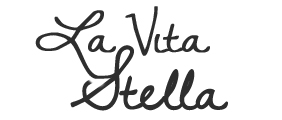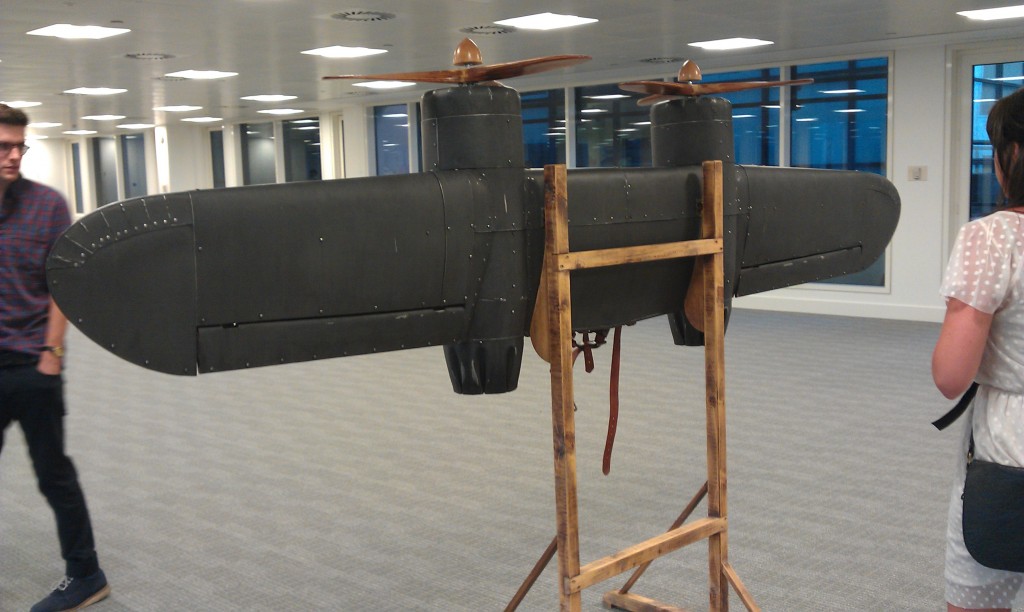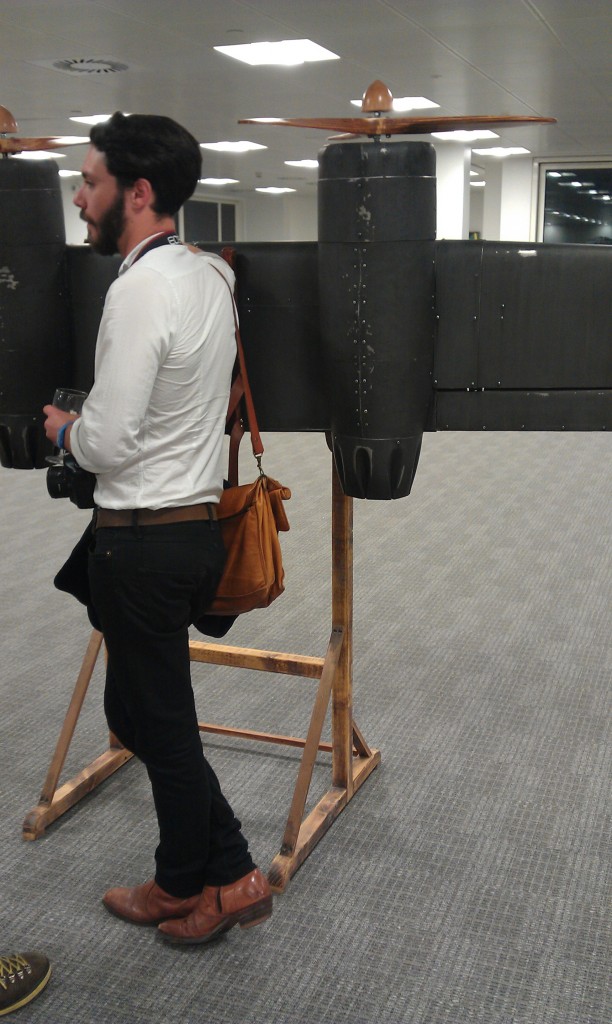The Tate Modern, National Gallery, Whitecube, National Portrait, the Serpentine, Saatchi……. familiar with the names? There are surely some favourites muddled amongst these, let alone the many other galleries and exhibition spaces not mentioned.
Not quite the same plethora of free resources in Johannesburg I’m informed, where the subject of this post hails from. George Winks; artist, knife-maker, designer. But let’s not pigeon-hole the man (as you’ll learn later).
Artists are stereotyped creatures; tormented, moved by things that the uncreative eye has little or no affinity with, thereby enabling a sheltered state that is necessary in order to create and stimulate artistic productivity; individuals perpetually all-consumed by their talent.
George could be described as such. He has an enigmatic air about him whilst puffing on his cigarette, adding to his mystique with a low pitched voice, which one must strain to listen to on occasion. This is not a contrived way of engaging though, George is simply not of a domineering nature. Now he will be the reluctant centre of attention due to the exhibition of a completed piece of work; Overture to Death.
Before launching into the exhibition though, one must have a background story so I delved into the making of Winks, or at least his artistic tendencies anyway.
Growing up in Johannesburg, George describes himself as a rather restless child. This South African city was an odd place, he explains, socially stunting and although huge, terribly cliquey. Born of Liberal parentage, he was subject to philisophical discussions at home from an early age and an environment of support and encouragement of thought; not something that was mirrored in his school life. Teachers followed the structure imposed on the curriculum, a stifling approach not suited to George’s disposition. Stubborn and strong-willed, he felt frustrated within the confines of Academia, creating a troublesome boy who did not enjoy being told what to do. George describes his school days with an acute unfondness and clear relief that this period is over. His forehead is deeply furrowed when he speaks of it; clearly not a happy point in his life.
But George fully acknowledges it and admires the perseverance of his parents who although never restrictive, managed to coax him to at least graduate.
George didn’t in fact go onto study Art at University, instead kicking around in odd jobs for a couple of years, without a real sense of his worth. He sketched a little, and at one exhibition at school a teacher mentioned “His art’s going to take him somewhere” however there was no honing in of his skill.
As was the case with many a South African resident, flyers circulated amongst the youths beckoning them to London, selling the dream of an average restaurant job and big city as an experience to be had. So George succumbed; within a couple of days of seeing a flyer he booked a flight. Having family in the UK, a dual passport and nothing to gain from staying, “When can I leave?” was the question that George asked the booking agents. The following Monday saw him in a restaurant placement as a Kitchen Porter. This experience taught George (with his middle class roots) that he could clean up pots and scrub floors with the best of them. A life lesson learnt early on which ensured a good work ethic was instilled.
The art itch was not quite scratched though and through friends of his parents, he chose to enrol on a skills-based programmed, focusing on technical mastery which George chose as, at the time, he saw art education as teaching people ‘how’ to think rather than giving them the tools necessary to manifest what they already thought (he now believes a mixture of the two is required).
It was not an easy course, but judging by George’s approach so far this would only be considered a plus point than a negative. He attended class daily, from Monday to Friday 8:30-17:30 and was subject to intense lessons with classes of no more than 9 students at a time and up to 8 teachers rotating throughout the week. Throughout the 1st year, work was produced with pencil ONLY, followed by the use of colour, working with water-colour, egg-tempera painting (http://en.wikipedia.org/wiki/Tempera), then incorporating fresco painting and print making (etching). The focus was truly to hone skills, with some unique and philisophical practices applied. Alongside the course he was working a part-time job too, so hard work and an unfaltering attitude was needed in order to gain more knowledge and a self-inflicted introspection of real talent.
After 3 years, George was fully educated in his artistic abilities. He completed the training with a complete understanding of how to paint, although now, he did not want to paint anymore! It sounded almost as though this long and arduous process was merely an exorcism of his art demon. “There are lots of ‘nice’ paintings out there”, George says, “but I’m not interested in nice! I don’t want to fill the world with more shit, I want to make things that DO something, with a traceable process of thought.”
In terms of influences or indeed other artists whose methods have been admired by George, he mentions Euan Uglow, a painter known for his meticulous and highly laborious approach to painting the human figure. He made no attempt to hide the construction of his paintings, a style that has clearly stuck with George.
George likes flaws. These are what makes things more interesting, he says. A lack of perfection, with an immediate vision of the struggle it took to get to that ‘final’ piece is what truly inspires George’s work.
His latest piece is based on a particular poem from a collection George had previously flicked though but re-embraced. It seems he was in need of a new project; paintings and works he had or was in the process of producing were ‘too cerebral’ and he was getting too bogged down in the intellectual content.
Cecil Day-Lewis, The Bombers (1938)
Through the vague morning, the heart preoccupied,
A deep in air buried grain of sound
Starts and grows, as yet unwarning –
The tremor of baited deepsea line.Swells the seed, and now tight sound-buds
Vibrate, upholding their paean flowers
To the sun. There are bees in sky-bells droning,
Flares of crimson at the heart unfold.Children look up, and the elms spring-garlanded
Tossing their heads and marked for the axe.
Gallant or woebegone, alike unlucky –
Earth shakes beneath us: we imagine loss.Black as vermin, crawling in echelon
Beneath the cloud-floor, the bombers come:
The heavy angels, carrying harm in
Their wombs that ache to be rid of death.This is the seed that grows for ruin,
The iron-embryo conceived in fear.
Soon or late its need must be answered
In fear delivered and screeching fire.Choose between your child and this fatal embryo.
Shall your guilt bear arms, and the children you want
Be condemned to die by the powers you paid for
And haunt the houses you never built?
In order to fully appreciate the piece at all, one must almost repeat the words of the poem in one’s head; “that ache to be rid of death”…. such a noun conjures such a powerful sensation, particularly from a female point of view. The dulled pain, the exacerbated need to be rid of such a painful affliction. And sure enough, it conjured up a feeling in George to make it real, to bring the words into physical space.
The project was long and he did not anticipate it taking 3 years. His initial plan was to create a sculpture to wear these wings. This involved more self-perpetuating education, gaining George further skills in geometry, carpentry and yet more barriers to its completion. George declares he has an addiction to learning. I could think of worse things to crave however they do seem to have an overwhelming effect on George. For example, upon learning how to paint he purposefully set-up a stream of projects for pieces he did not know what to do yet in order to create them. After 5 months, George scrapped his sculpted figure due to its pretence of life. He wanted a living person to wear these wings. The sculpture was intended to be lifelike, however, it would always have been a stand-in which was not what he wanted. He mentions not wanting things to ‘represent’ something else. The wings invariably fall short because they don’t work, they are a prop, a theatre piece. Wood and metal comprise their inanimate being. Over the 3 year period, it became a burden in many ways, George states woefully. Its completion spells the end of a deep relationship and he had evolved being much less moody than when he first began. He looks at the wings now as quite beautiful based on the the production it went through. There are mistakes, scratches and irregularities in the surface appearance which merely increase its allure in George’s eyes.
I ask what is next after such an upheaval to the attached ‘wings’. Furniture is where George’s creative talents now gravitate, which follows in his own Father’s dabbling in carpentry. Interestingly it is here that seems to mark George’s vocation in many ways; art and process combined. He speaks of a chair that he made which took 5 days for completion (what a contrast to his last work). Furniture making requires no justification, it just IS. A lot of social commentary seems to accompany art production these days according to George. As a generation, we are expected to make meta-physical items, not-so-interesting products of not-so-interesting subjects. The social status of an Artist too does not sit well with George, who shys away from attention.
Which plays perfectly into his next trade, a process over the result. And of course another project which forces him to learn. Perhaps the Design Museum is somewhere to add to the list of exhibition spaces of his future work.
THE EXHIBITION: SYSTEM OF OBJECTS, 55 Gracechurch Street
There was something rather melancholy about the whole experience when I finally witnessed the wings. Ultimately, this angel had rid itself of death which made it seem somewhat lonely but also very peaceful. No destruction was caused, there could only be speculation. Comments were pass on the materials used, the variants of colour and the models in the photos. But ultimately it was the learning process and the knowledge gained through technique that resulted in these discussions. The vessel for me WAS George. He had been released, 3 years gestation and it was its own ‘being’ now, left for interpretation. How liberating it must finally be for George to now be able to detach himself, not just from the physical but now the mental.
I noticed a humour arising amongst his companions as he clicked his camera playfully to capture the gazing admirers. What freedom is gained from the completion of a project…. a frivolity until the next focus consumes.
Looking over the project it seems quite worn in…..it has been touched, knocked and is imperfect. Just how he liked it; a process manifest in physicality. George had achieved his goal. True to himself, he had maintained what was most important to him.
Another lesson learned. Until the next project…
(313)



